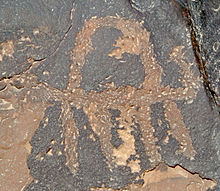
Back نقوش ما قبل التاريخ Arabic Petroqlif Azerbaijani Петрогліф Byelorussian Пэтрогліф BE-X-OLD Петроглиф Bulgarian Maenengravadur Breton Petròglif Catalan Petroglyf Czech Helleristning Danish Petroglyphe German
This article has multiple issues. Please help improve it or discuss these issues on the talk page. (Learn how and when to remove these messages)
|





A petroglyph is an image created by removing part of a rock surface by incising, picking, carving, or abrading, as a form of rock art. Outside North America, scholars often use terms such as "carving", "engraving", or other descriptions of the technique to refer to such images. Petroglyphs, estimated to be 20,000 years old are classified as protected monuments and have been added to the tentative list of UNESCO's World Heritage Sites. Petroglyphs are found worldwide, and are often associated with prehistoric peoples. The word comes from the Greek prefix petro-, from πέτρα petra meaning "stone", and γλύφω glýphō meaning "carve", and was originally coined in French as pétroglyphe.
In scholarly texts, a petroglyph is a rock engraving, whereas a petrograph (or pictograph) is a rock painting.[1][2] In common usage, the words are sometimes used interchangeably.[3][4] Both types of image belong to the wider and more general category of rock art or parietal art. Petroforms, or patterns and shapes made by many large rocks and boulders over the ground, are also quite different. Inuksuit are not petroglyphs, but human-made rock forms found in Arctic regions.
- ^ Wieschhoff, Heinrich Albert (1945). Africa. University of Pennsylvania Press.
Most noteworthy among the relics of Africa's early periods are the rock-paintings (petrographs) and rock-engravings (petroglyphs) which have been discovered in many parts of the continent.
- ^ T. Douglas Price (2012). Europe Before Rome: A Site-by-Site Tour of the Stone, Bronze, and Iron Ages. Oxford University Press. p. 116.
This art falls into two categories, depending on how it is made: petroglyphs are carved into rock, and pictographs are painted on the rock.
- ^ "petrograph". Merriam-Webster. Encyclopædia Britannica. Retrieved 26 November 2020.
- ^ Webster's Unabridged Dictionary of the English Language. Random House. 2001. p. 1449. ISBN 0-681-31723-X.